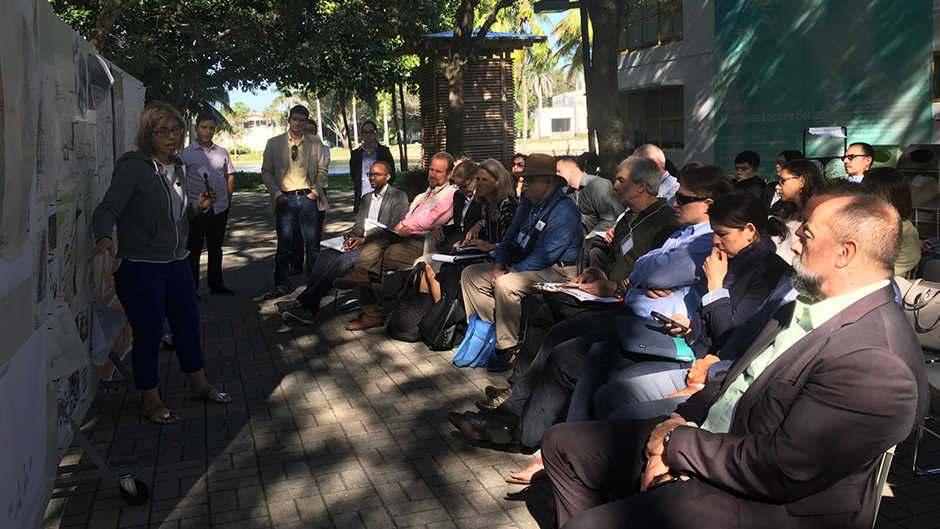“Over the coming century, as flooding events both on coastal and inland sites become more frequent, residents will either adapt or look for alternatives along higher grounds; increased density and intensity of uses in those areas is therefore likely,” said Chao, who also served as design co-lead for the team designing Arch Creek’s transit-oriented development (TOD) site.
Her design co-lead, urban designer Gustavo Sanchez-Hugalde, said that although urban patterns seem to have erased natural ones, nature has a memory and, in the face of climate challenges, natural patterns are increasingly re-emerging.
Among the proposed TOD site designs was the use of the TDR, or transfer of development rights, program, a policy tool that can move populations in more vulnerable areas to less vulnerable areas. The designs centered around creating flood-resistant transportation hubs—with “wet-proofed” ground floors—surrounded by mixed-use and multi-family home development.
In presenting his team’s vision for Arch Creek’s waterfront site, Anthony Abbate, professor of architecture at FAU, said the proposed floating docks, engineered mangroves, and raised streets and parking areas were a composite of the Standard Hotel in Miami Beach and the Highline in New York City. He also noted that the challenges sea-level rise and other climate change impacts pose to humans are unprecedented.
“Let’s not kid ourselves,” he said. “Sea-level rise is not something we, as a species, have ever dealt with.”
Ajani Stewart, environmental programs manager for the City of Miami and site captain for the Shorecrest site, reminded the audience that some of the neighborhoods vulnerable to sea-level rise are home to low-income populations.
“There is a very clear and present human story here,” said Stewart. “There are very real impacts being felt by economically vulnerable groups already dealing with the effects of sea-level rise.”
The short-term proposals in those neighborhoods include raising roads, installing small pump stations, and raising seawalls to protect against storm surges. In the mid-term, changes in density levels and zoning regulations also would have to be considered. Long-term proposals include creating more “amphibious” development.
The Lower Matecumbe Key team suggested increasing the use of multi-family housing and mixed-used development along the U.S. 1 corridor. Buffers to sea-level rise and storm surge would include restoration of Sea Oats Beach and increasing the use of mangrove islands and man-made offshore reefs.
“Getting the historical beach to its former glory is of particular interest,” said Chris Bergh, South Florida conservation director for The Nature Conservancy’s Florida Keys office. “So is interconnecting the system of waterways that is currently poorly connected.”
Bergh described how Lake Iseo in Italy is artistically dealing with sea-level rise and how those designs could be implemented in Lower Matecumbe Key. Even if homes are on stilts, he explained, we need to rethink how people access them. He suggested some areas can borrow Italy’s design of floating piers, or walkways, for people and light vehicles such as golf carts.
“Redesigning this area requires rethinking what we’ve been accustomed to thinking about with luxury homes, to something that’s a bit more humble and responsive to the environment,” said Steven Fett, lecturer at the School of Architecture and assistant director of the CUCD.
The presentations were followed by a panel discussion moderated by Katherine Hagemann, the sustainability officer for Miami-Dade County’s Office of Resilience who served as site captain for all three Arch Creek sites. Hagemann’s office recently oversaw a report by the Urban Land Institute and she worked closely with the three teams to ensure recommendations by the institute were considered in the designs.
One panelist, Islamorada Mayor Deb Gillis, noted that “the problem is how to incentivize people to increase density development, to move whole neighborhoods, and give up their individual access to coastal areas.”
In response, Stuart Kennedy, director of program strategy and innovation at the Miami Foundation, suggested emphasizing pilot projects in adaptation action areas.
Schneider, senior program officer with the Institute for Sustainable Communities, reminded the group that “we have to remember that we’re all in this together and, unlike the siloed developments of the past, we need to work together to tackle this head on.”
Also participating in the charrette: Rodolphe el-Khoury, dean of the School of Architecture; faculty from the Rosenstiel School of Marine and Atmospheric Science and the College of Engineering; members from the Resilient Miami Initiative and the Florida Climate Institute; local environmental design architect, German Brun; Max Zabala, School of Architecture alumnus; Ricardo Lopez, lecturer at the School of Architecture and assistant director of the CUCD; David Snow, planner with the City of Miami Department of Planning and Zoning; Susan Sprunt, environmental resources program manager for the Islands of Islamorada; FIU faculty members Marta Canves and Marylis Nepomechie. Other panel discussion members included Jack Osterholt, Miami-Dade County Deputy Mayor and director of regulatory and economic resources; and Mike Roberts, CEP, PWS, senior administrator of environmental resources in Monroe County’s Planning and Environmental Resources Department.

